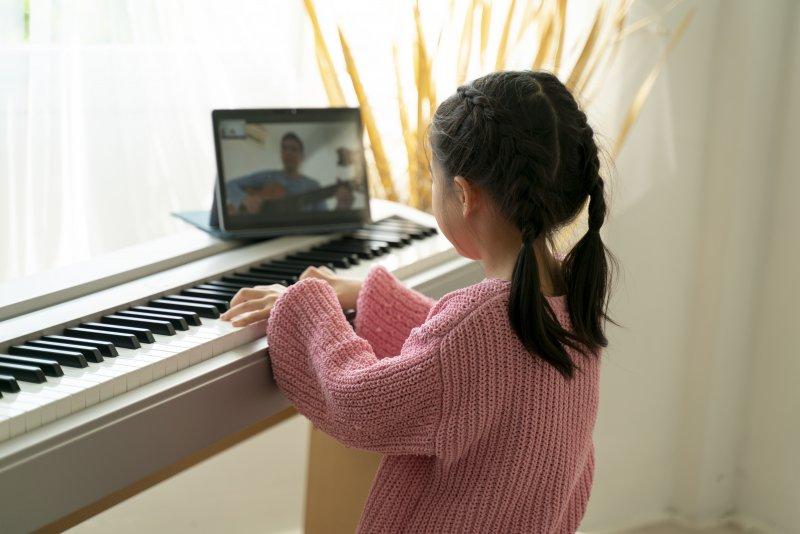We’ve discussed how to practice the piano before… but what if you don’t have 30 minutes or an hour to commit to practicing every day? Answer: Condense it into a 10-minute quick-practice! Read on as Austin, TX piano teacher Aimee B. shows how to make this piano exercise work for you…
Are you a busy student with no time for a lengthy piano practice session? If so, this 10-minute challenge is perfect for you! In just 10 minutes, you can work on your technique, dexterity, and repertoire.
Here’s how to do it.
How Can I Practice Piano By Myself?
If you’re trying to learn piano by yourself, there are a few things you can do to make the process a little easier.
- Find a quiet place to practice where you won’t be interrupted.
- Set some realistic goals for yourself and practice regularly.
- Break down pieces into manageable chunks so you can focus on one thing at a time.
- Don’t be afraid to ask for help when you need it.
- Use resources available to help you learn piano, like videos, books, and online tutorials.
Naturally, one of the best ways to learn how to play piano is to work with a piano teacher. They’ll be able to tell you everything you need to know in order to hone your craft. You can also watch YouTube videos, like the one you see below:
https://www.youtube.com/watch?v=Ab9zfL9pPnA
How to Practice Piano With Zero Time
No doubt you are busy. On top of a full day, you have an inkling to learn the piano. But how do you fit it into your day? You know the importance of regular practice, but if you find the idea of sitting and studying for 30 minutes entirely too daunting, you’re not alone.
In fact, many adults use being busy as an excuse to put off taking piano lessons. But the truth is, even if you don’t have 30 minutes to commit to practicing every single day, you can still make some progress. There is a powerful and productive way to think about practice in small, incremental steps. Visiting the piano for as little as 10 minutes a day can reinforce new material and create a ritual that becomes an integral part of your life.
Before I break it down, I’d like to offer two important piano practice tips:
1) Create a Unique Practice Space
Choose and prepare a specific, music-friendly practice space in your home. Whether it’s a certain corner in the living room or an entire music room, see that the area is clean and free of distraction. Make it your creative space and decorate it as such by hanging a picture of your music idol to inspire your practice or lighting candles to encourage calmness.
Leave your practice space ready with your books and metronome, and keep your keyboard lid open! Do not let the articles of your everyday life, like papers, backpacks, or groceries intrude on this space. Maintaining a clean and ready piano practice space invites you to sit and make music.
2) Practice With a Side Salad… Or Set an Alert
The key to practice is first designating a set time. Instead of leaving your piano practice time floating ambiguously in the ether of “later,” try coupling it next to an activity you already do daily, like eating or brushing your teeth. Ten minutes directly before or after dinner is an easy target practice zone.
Also, use your calendar and alert systems on your computer and smartphone to their full capacity. Set an alert to remind you. Let technology support your practice. With time, you’ll develop your practice habit as a daily ritual instead of a chore that gets pushed to tomorrow.
Now, on to the piano exercise!
10-Minute Piano Practice Challenge – Overview
Share this Image On Your Site
10-Minute Piano Practice Challenge – A Closer Look
In order to make the most of your practice time, it’s important to be efficient with your work. In this blog post, we’ll look at a 10-minute piano practice challenge that can help you improve your skills quickly. Keep reading for more information!
1 min: Breathing and Visualization
Before you begin this piano exercise, approach the keys with a calm and positive mind. Take a minute to breathe deeply and visualize yourself actualizing your musical goal. Feel your feet touching the ground and your body lengthening from the bench. Place your hands in a middle C position and, if possible, visualize their movement while reviewing your music with your eyes. Try to maintain a “can-do” attitude and dismiss any harsh criticism of yourself. Remember, learning how to play the piano is a process!
2 min: Review Notes
Take a moment to recall your last lesson. Read any notes from your piano teacher and identify the specific points you need to focus on for this practice, like counting and dynamics. Limit your focus to one or two items to improve upon. Don’t try to tackle everything at once.
5 min: Work on Targeted Assignment
With these one or two items in mind, approach your current assignment. Write down any questions that arise during your practice to ask your teacher at the next lesson.
2 min: Review Previously Completed Song/Exercise
Reward your focus by reviewing a previously completed assignment that you feel confident in. Have fun playing and realize you are slowly building a repertoire.
NOTE: You can also practice your piano theory away from the keyboard. Try downloading a popular tablet or smartphone app like Music Tutor and visiting notation exercises away from your instrument, while standing in line, waiting at an appointment, or on a lunch break. Apps are also good attention diversions if you need a challenge or feel like your practices are getting mundane.
[Editor’s Note: Here are some other piano apps we love!]
Other Piano Practice Routine Ideas
Which routine works best for you when it comes to practicing the piano?
Are you someone that needs total silence in order to focus, or can you practice with a little bit of noise in the background?
Do you like to take breaks every once in a while, or are you able to practice for long periods of time without stopping?
Although there is no “wrong” way to practice, some people may find that they work better using one specific method, while others may enjoy using a variety of different practices.
Here are a few different ways that you can practice the piano and how each routine might be beneficial for your playing.
Piano Sight Reading Practice
Reading music notation is a skill that takes time and practice to develop. If you don’t have a lot of time to devote to sight reading practice, there are a few things you can do to make the most of your time.
First, focus on reading one clef at a time. Once you’re comfortable reading treble or bass clef, you can start practicing both simultaneously. Another helpful tip is to break up the music into small sections and practice each section slowly at first.
As you become more familiar with the notes and rhythms, you can gradually increase your speed.
Lastly, don’t be afraid to make mistakes! The more you sight read, the better you’ll become at it.
With a little practice, you’ll be surprised at how quickly your reading skills improve.
Piano Practice Piece for Rhythm
As a piano student, it is important to practice your rhythm regularly. This piece is a great way to improve your rhythm skills. The first thing to do is to clap the rhythms indicated in the sheet music.
Once you are comfortable with the rhythms, try playing them on the piano. Start by playing just the right hand, then add in the left hand when you are ready. Remember to keep the tempo steady and even.
With practice, you will be able to play this piece with ease and confidence.
Scales and Arpeggios
If you’re short on time but still want to make the most of your piano practice, focus on scales and arpeggios. These essential technical exercises will help to improve your finger strength and dexterity, and they can be practiced relatively quickly.
Start by warming up with some easy scales, such as C major or G major. Once you’ve loosen up your fingers, move on to a few arpeggios.
Again, start with some simple patterns before progressing to more challenging passages. With a little bit of focus and practice, you’ll be able to master those difficult pieces in no time.
Other Piano Exercises
If you’re short on time but still want to get some piano practice in, there are a few other exercises you can try. One is to focus on perfecting a single piece. If you can play it perfectly from start to finish, you’ll be well on your way to becoming a master of the piece. Another exercise is to work on your speed. See how fast you can play a particular passage or piece without making any mistakes.
With enough practice, you’ll be able to play at breakneck speeds and still sound great.
Finally, don’t forget to warm up before you start playing. A few simple stretches and scales will help loosen up your fingers and prepare them for a vigorous session of piano playing.
By incorporating these exercises into your practice routine, you’ll be able to make the most of your limited time and still become a better pianist.
How Many Hours a Day Should You Practice Piano?
How many hours a day should you practice piano? This is a question that is often asked by beginner and intermediate level players.
The answer, like with most things, is that it depends. If you are just starting out, you may only need to practice for 30 minutes a day. As you get more advanced, you may need to practice for 2-3 hours a day. Ultimately, the amount of time you need to practice will depend on your goals and how quickly you want to improve.
If you are just trying to learn the basics of piano, then 30 minutes a day is probably sufficient. However, if you are hoping to become a concert pianist, then you will need to put in many hours of practice each day.
The best way to figure out how much time you need to practice is to speak with your teacher or take an online course that can help you assess your skill level and goals. With a little bit of guidance, you should be able to set a practice schedule that works for you.
How Much Piano Practice is Too Much?
You might be wondering, “can you over practice piano?” Unfortunately, yes, you can.
Practice makes perfect, or so the saying goes. But when it comes to piano practice, how much is too much?
If you find yourself struggling to make time for other activities or neglecting your social life in favor of extra hours at the keyboard, it may be time to take a step back and reassess your priorities.
Of course, there is no magic number of hours that all pianists should aim for, as everyone’s individual needs will differ.
However, most experts agree that two to three hours of practice per day is generally sufficient to make good progress without burning out.
So if you find yourself routinely going above and beyond this amount, it may be worth reconsidering your approach. Piano should be a source of enjoyment, not frustration.
By striking a balance between practice and leisure, you can ensure that your passion for music remains alive for years to come.
How to Really Improve Your Piano Skills
How to Really Improve Your Piano Skills
Decide that you are willing to give this method an earnest try for one week, running through the piano exercise each day. Remember, it’s only 10 minutes! Reward yourself at the end of that week for meeting your goal. Then, reflect on your experience. Is your daily practice coupled with the appropriate daily event or do you need to move it to a different event? Did 10 minutes feel too short, too long, or just right? How did you feel before, during, and after your practice? Do you feel more or less inspired? Look at your experience and evaluate.
By the end of one week you will have achieved 70 minutes of intentional and structured practice. Any music teacher will be thrilled by your report and excited by your commitment to steady progress. Of course, if a burst of inspiration hits you and 10 minutes turns into 20, then great, go with it. The 10-minute piano challenge is a starting point.
The best way to improve your skills as a piano player, no matter how much time you have, is to hire a piano teacher. They’ll show you the ropes and how to get the most out of your practice routine – no matter how much or how little time you might have.
Good luck!
 Post Author: Aimee B.
Post Author: Aimee B.Aimee B. teaches piano, guitar and music theory in Austin, TX. She earned her B.A. in philosophy and art from St. Edward’s University, has worked as a professional musician for over ten years, and has taught over 100 students as a private music instructor. Learn more about Aimee here!
Photo by Tuan Hoang Nguyen
Suzy S.


